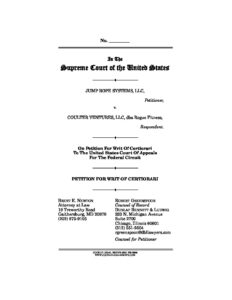By J. Brian Loker
Jump Rope Systems, LLC. (“Jump Rope Systems”) has filed a petition for certiorari with the US Supreme Court following the Federal Circuit summarily affirming a Patent Trial and Appeal Board (PTAB) decision invalidating two of Jump Rope System’s patents. Jump Rope Systems had obtained two patents, US 7,789,809 and US 8,136,208, related to jump rope precision speed handles. After discovering potential infringing activity, Jump Rope Systems filed an infringement suit in the District Court in the Southern District of Ohio. Subsequently, during an inter partes review (IPR) proceeding initiated by Rogue Fitness at the PTAB, the ‘809 and ‘208 patents were deemed unpatentable. The Federal Circuit summarily affirmed the decision by the PTAB, and the District Court subsequently dismissed the infringement suit based on the collateral estoppel doctrine under the Federal Circuit precedent in XY, LLC. V. Trans Ova Genetics, L.C., 890 F. 3d 1282 (Fed. Cir. 2018). The petition for certiorari seeks to overturn the Federal Circuit precedent to apply the collateral estoppel doctrine to bar patent infringement suits based on a determination by the PTAB.
Recently, three amicus briefs were filed in support of the petitioner’s position. The arguments advanced by Jump Rope Systems and supported by the amicus briefs is that a decision by the Federal Circuit that relies on a lower burden of proof should not bar further proceedings in an Article III court that relies on a different standard of proof. In particular, Jump Rope Systems and amici argue that the Court should reverse a patent-only rule that allows a PTAB invalidity decision based on a preponderance-of-the-evidence standard to give rise to collateral estoppel in District Courts that are bound to evaluate the issue under a clear-and-convincing-evidence standard. Essentially, the Supreme Court is being asked to overturn XY, LLC. in order to harmonize the collateral estoppel doctrine inside and outside of the patent sphere.
While we wait to receive a decision on the petition for certiorari, the outcome of this case could drastically affect how patent infringement actions are being litigated. Currently, each litigation that asserts at least one patent infringement action is likely to spawn an IPR proceeding in the PTAB seeking to invalidate one or more claims of the asserted patent(s). The IPR proceeding also typically causes a stay of the District Court litigation while the PTAB considers the validity issue. If the Supreme Court accepts the case and decides that a patent validity decision made at the PTAB and affirmed by the Federal Circuit under a lower standard of proof is not binding on the District Court infringement action, then alleged infringers may alter their response to an infringement action. On the one hand, alleged infringers may continue to file IPR actions with the PTAB. On the other hand, alleged infringers may decide to litigate invalidity in the District Court proceeding alone. Furthermore, if alleged infringers continue to file IPR actions in the PTAB, then PTAB decisions and District Court litigation may proceed in tandem and could, in some circumstances, lead to different outcomes that are ultimately decided by appeal to the Federal Circuit.

